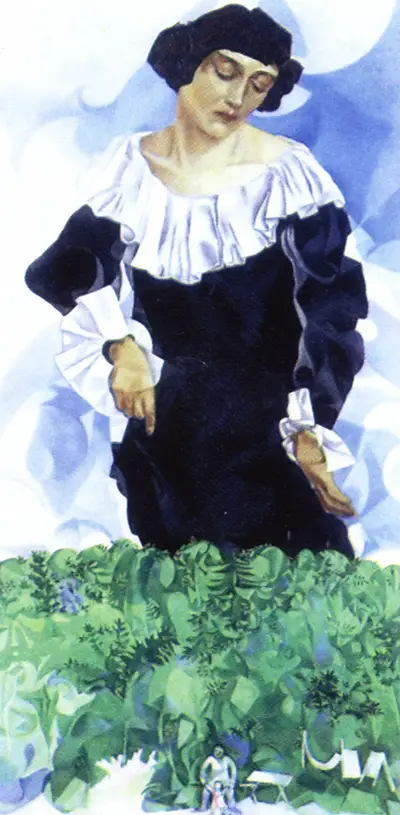This particular painting is undoubtedly the most eminent portrait of his wife, Bella. He was known to have said that only love interests him and that he is in contact only with things that rotate around love. Chagall uses his art to serve as a memory of the Hasidic backgrounds and traditions of his Jewish history and heritage in an attempt to prevent them from disappearing. It is in his home town, Vitebsk, that he learnt to paint. In this painting, Bella with white Collar, there are two tiny individuals at the centre bottom right at the forefront of Bella’s portrait. As the couple’s daughter, Ida was born a year before this painting was done, it is thought that those two individuals depict the artist, Marc, and their daughter, Ida.
In this oil canvas, his brushes have danced with hues of azure blue for the sky with a light yellow shade in the distance depicting some sunlight, then shades of green in the shrubbery beneath and his Bella’s attire, a black gown with white sleeves and a white collar. Inspiration seems to have been drawn from the Assumption of the Virgin Mary. Bella’s larger than life size in comparison to her surroundings depicts how big a heart and how full of love Marc felt she was. It is said that when they first met, they immediately fell in love.
The style of art used in this painting is that of modernism and cubism. There were several perspectives that directed Chagall's art, including Expressionism, Fauvism, Surrealism and Cubism. His use of innovative, quirky scenery and play with colour made him stand out from other painters and made his works popular. Although many modernist canvases technically approached their work in theory, the work of Chagall had a defined human eminence to it. Other defining factors that influenced his works were his fellow artists like Amedeo Modigliani, Robert Delaunay, and Chaim Soutine. He also drew influences from literary individuals as well; the likes of Guillaume Apollinaire, Fernand Leger, and Blaise Cendrars. This oil on canvas portrait painting is presently displayed at the Centre Pompidou in Paris.

